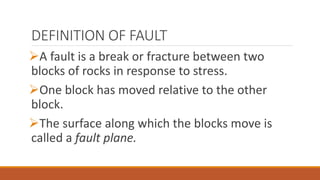Fault
- 2. DEFINITION OF FAULT A fault is a break or fracture between two blocks of rocks in response to stress. One block has moved relative to the other block. The surface along which the blocks move is called a fault plane.
- 3. RELATIONSHIP OF FAULT AND EARTHQUAKE Faulting produced the earthquakes. Thus earthquakes may occur because: a) Rocks are initially broken to produce a fault. b) Movement or re-activation of an already existing fault.
- 4. Fault Movement = Earthquakes An earthquake is caused by a sudden slip on a fault. The tectonic plates are always slowly moving, but they get stuck at their edges due to friction. When the stress on the edge overcomes the friction, there is an earthquake that releases energy in waves that travel through the earth's crust and cause the shaking that we feel.
- 5. Focus- where the slip happens below ground Epicenter-where the shaking is first felt above ground directly above the focus.
- 6. Three types of stresses produce faults: 1) Tension- causes rocks to stretch and also break to produce a fault. 2) Compression- causes rocks to fold and ultimately break to produce a fault. 3) Shear- forces producing shear strain
- 7. TERMINOLOGY STRIKE – a horizontal line along the direction of a fault plane. DIP – the angle between the fault plane and the horizontal. Hanging wall – is the block above the fault plane. Foot wall - is the block below the fault plane.
- 9. Normal Fault The hanging wall moves down relative to the foot wall. This fault type is caused by tensional stress.
- 10. Normal Fault
- 11. Normal Fault
- 12. Normal Fault
- 13. Reverse Fault The hanging wall moves up relative to the foot wall. This fault is caused by Compressional stress.
- 14. Reverse Fault
- 15. Reverse Fault
- 16. Reverse Fault
- 17. Strike-Slip Fault The fault exists between two pieces of crust and the Movement occurs horizontally where the sides slide past each other. This fault type is caused by shear stress.





















